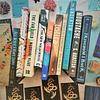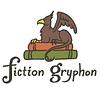Take a photo of a barcode or cover
Overall rating: 5/5
Plot: Some basic information about the story, I do want to avoid giving spoilers, is that the format of the book is a little different to traditional YA novels. It is written in the form of letter, texts, writing, etc. with each chapter focusing on one of the three characters. I have read other novels, not YA, in this structure and I have always been fond of this form of storytelling. It allows so much of the personality of each character to shine through without having to do much character building from the bottom up. It is a time saver and also an enjoyable way to fall in love with characters. The writing is beautiful and the insights to life are relatable and at times heart wrenching.
Final Thoughts: I’m not going to lie, the last 5 chapter of the book had me raving and crying and oscillating from anger to sympathy and sadness. It was not until the end of the book that I realize how badly I wanted the impossible storybook ending and the wave of emotions Josie, the main protagonist, goes through I went through with her. I was a crying mess at the end of the novel, but some books are meant to bring out strong emotional responses. I both loved and hated the ending because even though I know the ending is great and the message about love is beautiful there is a small part of me that still wishes for the impossible.
Plot: Some basic information about the story, I do want to avoid giving spoilers, is that the format of the book is a little different to traditional YA novels. It is written in the form of letter, texts, writing, etc. with each chapter focusing on one of the three characters. I have read other novels, not YA, in this structure and I have always been fond of this form of storytelling. It allows so much of the personality of each character to shine through without having to do much character building from the bottom up. It is a time saver and also an enjoyable way to fall in love with characters. The writing is beautiful and the insights to life are relatable and at times heart wrenching.
Final Thoughts: I’m not going to lie, the last 5 chapter of the book had me raving and crying and oscillating from anger to sympathy and sadness. It was not until the end of the book that I realize how badly I wanted the impossible storybook ending and the wave of emotions Josie, the main protagonist, goes through I went through with her. I was a crying mess at the end of the novel, but some books are meant to bring out strong emotional responses. I both loved and hated the ending because even though I know the ending is great and the message about love is beautiful there is a small part of me that still wishes for the impossible.
Received an ARC of this audiobook from NetGalley.
Overall rating: 5/5
Plot: Some basic information about the story, I do want to avoid giving spoilers, is that the format of the book is a little different to traditional YA novels. It is written in the form of letter, texts, writing, etc. with each chapter focusing on one of the three characters. I have read other novels, not YA, in this structure and I have always been fond of this form of storytelling. It allows so much of the personality of each character to shine through without having to do much character building from the bottom up. It is a time saver and also an enjoyable way to fall in love with characters. The writing is beautiful and the insights to life are relatable and at times heart wrenching.
Final Thoughts: I’m not going to lie, the last 5 chapter of the book had me raving and crying and oscillating from anger to sympathy and sadness. It was not until the end of the book that I realize how badly I wanted the impossible storybook ending and the wave of emotions Josie, the main protagonist, goes through I went through with her. I was a crying mess at the end of the novel, but some books are meant to bring out strong emotional responses. I both loved and hated the ending because even though I know the ending is great and the message about love is beautiful there is a small part of me that still wishes for the impossible.
Overall rating: 5/5
Plot: Some basic information about the story, I do want to avoid giving spoilers, is that the format of the book is a little different to traditional YA novels. It is written in the form of letter, texts, writing, etc. with each chapter focusing on one of the three characters. I have read other novels, not YA, in this structure and I have always been fond of this form of storytelling. It allows so much of the personality of each character to shine through without having to do much character building from the bottom up. It is a time saver and also an enjoyable way to fall in love with characters. The writing is beautiful and the insights to life are relatable and at times heart wrenching.
Final Thoughts: I’m not going to lie, the last 5 chapter of the book had me raving and crying and oscillating from anger to sympathy and sadness. It was not until the end of the book that I realize how badly I wanted the impossible storybook ending and the wave of emotions Josie, the main protagonist, goes through I went through with her. I was a crying mess at the end of the novel, but some books are meant to bring out strong emotional responses. I both loved and hated the ending because even though I know the ending is great and the message about love is beautiful there is a small part of me that still wishes for the impossible.
This book was so lovely. It was such a sweet story of romance and friendship. I loved the beautiful prose and epistolary structure. It drew me in and had me falling in love with Elias too.
I don't like reading emails between characters.
slow-paced
Dual timelines? Check! Epistolary fiction? Check! In Dearest Josephine by Caroline George, 1820 and 2020 don’t seem so many years apart, not when an incomplete manuscript, a collection of unsent letters, and a secluded manor in Northern England transcend the ages to hint at a star-crossed would-have-been romance.
The life and times of the 1800s differ greatly from those of the 2000s, but author Caroline George writes both periods with realism and accessibility. In these two time-separated worlds, characters find commonalities and connections. They find the spaces where their stories intersect as they navigate life in a remote estate and a love that cannot be. Dearest Josephine is complicated in terms of time and setting, and yet it is written so effectively that these things are as clear and simple as can be. Undoubtedly, the epistolary form plays an important role in making this story easy to read despite its triple plot (keep track of what’s then, what’s now, and what’s the imagination of a nobleman’s son in love).
In two-hundred-year-old letters and a novel left behind, ever-romantic Elias Roch details his experiences of life during Regency period and of his insta-love fall for the mysterious Josephine de Clare. Meanwhile, present-day Josie de Clare arrived at a manor to find herself, instead finding Elias’s letters and manuscript, which leave her wondering if it is possible, even after all these years, that she could be Elias’s elusive love.
Present-day Josie soon finds herself falling for Elias. Communicating her experiences through emails with her best friend, Faith, and text messages to local boy Oliver, Josie shares lessons learned from Elias, from the seclusion of her new life at the manor, and from the impossibility of a love that defies the constraints of logic and time.
Dearest Josephine is unique and innovative—something new on the YA scene. If you like atypical story arcs and writing styles, this one is for you!
Thank you, NetGalley and Thomas Nelson for providing me with this eARC.
Want to talk about the book? Find me on Instagram!
The life and times of the 1800s differ greatly from those of the 2000s, but author Caroline George writes both periods with realism and accessibility. In these two time-separated worlds, characters find commonalities and connections. They find the spaces where their stories intersect as they navigate life in a remote estate and a love that cannot be. Dearest Josephine is complicated in terms of time and setting, and yet it is written so effectively that these things are as clear and simple as can be. Undoubtedly, the epistolary form plays an important role in making this story easy to read despite its triple plot (keep track of what’s then, what’s now, and what’s the imagination of a nobleman’s son in love).
In two-hundred-year-old letters and a novel left behind, ever-romantic Elias Roch details his experiences of life during Regency period and of his insta-love fall for the mysterious Josephine de Clare. Meanwhile, present-day Josie de Clare arrived at a manor to find herself, instead finding Elias’s letters and manuscript, which leave her wondering if it is possible, even after all these years, that she could be Elias’s elusive love.
Present-day Josie soon finds herself falling for Elias. Communicating her experiences through emails with her best friend, Faith, and text messages to local boy Oliver, Josie shares lessons learned from Elias, from the seclusion of her new life at the manor, and from the impossibility of a love that defies the constraints of logic and time.
Dearest Josephine is unique and innovative—something new on the YA scene. If you like atypical story arcs and writing styles, this one is for you!
Thank you, NetGalley and Thomas Nelson for providing me with this eARC.
Want to talk about the book? Find me on Instagram!
Name: Dearest Josephine
Author: Caroline George
Genre: Fiction, Romance
Rating: 3.5/5
Review:
Dearest Josephine is a wonderful story which is full of emotions and hope.
When Josie Declair moves to an old manor in North after her father's death, she finds a stack of old letters, each addressed to Josephine Declair. Elias letters are like solace and hope for Josie.
Seperated by 200 years, Josie and Elias find solace and love in each other. The lines between fiction and reality blurs when Caroline George pulls out an amazing story, which sweep our hearts off the floor.
The writing style is rave, while the plot is surprising and unique. The story is told from Josie's Point of View, while the story is divided into three parts, Josie's, Elias Letters and his Novel. The narrator was nice, but she could have done a better job, her voice did not express the Josie's feelings as it did! It is a book which will be enjoyed and loved by readers who enjoy reading parallel timel lovestory/parallel dimension love/parallel universe lovestory.
Author: Caroline George
Genre: Fiction, Romance
Rating: 3.5/5
Review:
Dearest Josephine is a wonderful story which is full of emotions and hope.
When Josie Declair moves to an old manor in North after her father's death, she finds a stack of old letters, each addressed to Josephine Declair. Elias letters are like solace and hope for Josie.
Seperated by 200 years, Josie and Elias find solace and love in each other. The lines between fiction and reality blurs when Caroline George pulls out an amazing story, which sweep our hearts off the floor.
The writing style is rave, while the plot is surprising and unique. The story is told from Josie's Point of View, while the story is divided into three parts, Josie's, Elias Letters and his Novel. The narrator was nice, but she could have done a better job, her voice did not express the Josie's feelings as it did! It is a book which will be enjoyed and loved by readers who enjoy reading parallel timel lovestory/parallel dimension love/parallel universe lovestory.
This book time travels between the 18oos and present day as Josie finds a stack of old letters from Elias Roche. He is writing to her from the past, and describes her perfectly, all her features and all her little quirks. As she begins to read the novel he's written about his relationship with Josephine from his time, she begins to fall in love.
The novel is written in epistolary form with Josie's texts in the 21st C contrasting well with Elias' more formal letters, but then after a while I found that the texts interrupted the flow, and the story started to drag.
The novel is written in epistolary form with Josie's texts in the 21st C contrasting well with Elias' more formal letters, but then after a while I found that the texts interrupted the flow, and the story started to drag.





